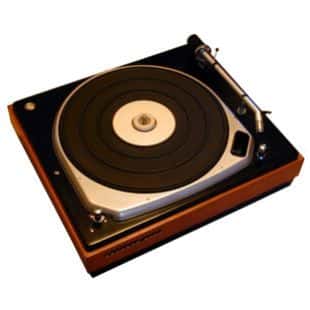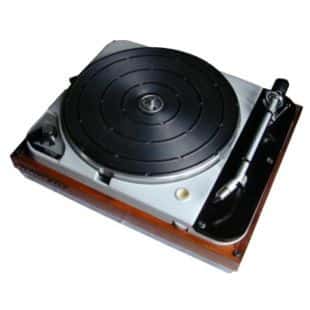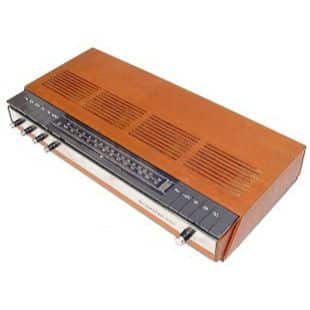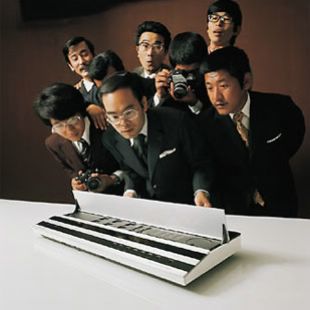BeoGram 3000 (1967)

Very rare deck produced for the Dutch and UK market in place of the Thorens based Beogram 3000 and also designed to partner the Beolab 5000 range, this deck was actually made by Acoustical of Holland.

Very rare deck produced for the Dutch and UK market in place of the Thorens based Beogram 3000 and also designed to partner the Beolab 5000 range, this deck was actually made by Acoustical of Holland.

In 1967, B&O found themselves with a world leading Hi-Fi system in the Beolab 5000 but no suitable source for the reproduction of LPs. In a move now commonplace, they simply outsourced and used the motor unit of the Thorens TD124 Mk II – probably the best available to them at this time. They added their own ST/L arm and re-christened it the Beogram 3000.
This deck was sold in those areas allowed by Thorens which initially did not include the UK. A different model was supplied there.Highly sought after by collectors now despite really having little to do with B&O! Some even dispensed with the B&O arm and use an SME tone-arm.
These days the Beogram 3000 Thorens is a sought after model, offering probably the best performance of any Beogram. Because it is basically a Thorens deck, parts are readily available in re manufactured form.
The standard arm was the ST/L but a few were fitted with the rare ST/P arm. This was a 12″ arm but used the earlier SP2 cartridge rather than the SP8 which was fitted to the ST/L when used in the Beogram 3000.
The lid fitted was a lift off device and was high to clear the lift mechanism of the arm.

Beomaster 1000 – a compact all-transistor hi-fi 2 x 15 watt stereo amplifier equipped with a highly selective FL radio with extended FM band (to 108 MHz), 3-gang tuning capacitor and 4-stage intermediate-frequency amplifier, automatic control circuit which locks on FM stations and keeps them accurately tuned.
It is prepared for single-transmitter stereo broadcasts, having a B&O multiplex adaptor (stereo decoder); it is also equipped with a pilot lamp (“Beo-Beacon”) which lights up when the receiver is tuned to a station transmitting an FM stereo programme.
The stereo amplifier, which plays both stereo and mono gramophone records, delivers no less than 2 x 15 watts of power output; piano-key speaker change-over switches which control two sets of stereo speaker systems, separate extra-efficient bass and treble controls; balance control for correct stereo sound distribution; physiologically compensated volume control (provides full balance at all volume levels throughout the tonal range); separate scratch and rumble filters; piano-key switching between mono and stereo reproduction; piano-key selectors for switching between the following types of operation: FM Broadcasting, FM Automatic Frequency Control; Tape Recorder; Gramophone 1; Gramophone 2.
Dimensions: 87mm high, 505mm wide, 24mm deep.
Choice of teak or Brazilian rosewood finish. Awarded the 1966 iF Prize for Industrial Design”

This top-operated receiver was not just exciting in appearance, it was also designed to facilitate operational comfort.
Primary controls were easily accessible, while the rarely used secondary regulators were concealed. The large tuning scale had calibrations in MHz and channel numbers. Tuning accurately to a desired station was child’s play because the large transparent slider was also provided with three small thumbwheels which assisted fine tuning.
Your three favourite stations could be pre-set by individual controls which were safely concealed beneath a sliding panel on the upper right hand side of the set. Subsequent programme selection was by easy pushbutton. The use of Field Effect Transistors (FETs) and Automatic Frequency Control (AFC) ensured optimum FM reception and compensated for weak signal conditions during tuning.
The amplifier’s power output was 2×15 watts RMS or 40 watts total music. Ambiophonic reproduction could also be obtained simply by connecting four loudspeakers, 2 in front and 2 to the side. In this way you could obtain an ‘extended’ stereo reproduction, a more realistic recreation of musical experiences recorded, for example, in a concert hall, because ambience or room information were included as well as direct musical information. There was a push button, the ‘ambio filter’, by which you could damp or reduce the highest tones (treble) reproduced in the side speakers. This was sometimes desired since the reflected sound which is reproduced in the side speakers is mostly mid-range tones. By damping high tones in the side speakers you could obtain a more natural sound reproduction.
Balance regulation was solved in a unique way in Beomaster 1001. Volume was controlled by two sliders, one for right and the other for left channel. The two sliders cold be operated together with one grip or separately, so that the balance between the channels could be adjusted as desired. The receiver’s slim, compact cabinet allowed several playing positions. Mounted on a wall (with special mounting bracket), slightly slanted (by special supports fitted to its base), or the traditional horizontal position. There were connections for record-player (switchable between high and low ohms), tape-recorder, headphone and four loudspeakers. A light indicated when the receiver was switched on, when the FM programme source was in use and whether a programme was in mono or stereo.
Receivers and amplifiers with the ambio function were products which, apart from stereo, could also reproduce the ambience or sound information of a room. Ambient information was included on most stereo vinyl recordings but could not be reproduced by a sound system with two loudspeakers or an ordinary stereo amplifier. Bang & Olufsen systems with the ambio function had facilities which electronically subtracted the difference signal (i.e. the difference between left and right channels) which contained ambient information. This information was fed into two extra loudspeakers which were placed as side speakers in a room. Ambiophony was an extension of stereo reproduction and enhanced the sense of realism. It could be used with nearly all stereo programme materials.
FM room aerial
In order to receive FM programmes, an FM aerial must be connected to the Beomaster 1001. Within a certain radius of the transmitter you could use the Bang & Olufsen FM room aerial, type 8902010. This aerial was easily fitted and the telescopic elements could be pulled out and positioned favourably.
Wall mounting
If desired, the Beomaster 1001 could be mounted on a wall by means of a special bracket. type 8920243. The bracket was screwed onto the wall and the receiver easily hung in position.

The 1970’s were exciting times for Bang & Olufsen. Another breakthrough during this decade was Beomaster 1900, a radio receiver and amplifier launched in 1976. Once again, design and operation differed dramatically from other contemporary products.
Originally designed by Jacob Jensen, Beomaster 1900, together with Beomaster 2400-2 were two advanced FM stereo receivers. They had identical technical specification and performance. Both were easy to use and easy to live with. Beomaster 2400-2 had the additional convenience of a cordless ultrasonic remote control module by which you could operate radio, amplifier and Beogram 2400 or 4004 record deck from a distance. Both receivers had touch-sensitive controls for operating the features and functions you used every day. All the secondary switches and adjustments were protected beneath a hinged lid, but an illuminated readout panel showed you the set’s operational status at a glance.
Beomaster 1900 boasted a powerful 2 x 30 watts RMS amplifier with distortion of less than 0,13%, five pre-set FM stations and comprehensive connection facilities. To operate it you simply touch the application “dimples” on the set’s front panel. The radio section had 4 pre-set stations which could be summoned at a touch and the phase-lock loop decoder provided excellent stereo separation even in difficult reception conditions The volume level could be pre-set at low, medium or high, and the music would always start at this level however much the volume control was altered last time the set was used.
The sets’ controls were divided into primary and secondary functions. The latter, which were less frequently used, were placed underneath the hinged aluminium panel where they were protected from dust and accidental movement.
A clear distinction was therefore made between the primary choice – accessible through a light touch – and the secondary choice, concealed under a lid hiding what the user did not need for daily use. At a stroke, what had been the norm for hi-fi in the past, with its macho grip and buttons, was eliminated. Instead, designer Jacob Jensen created a new design language, flat ‘flush-designed’ and electronically communicating, which did not target a few techno-freaks, but a much wider audience who wanted music rather than hi-fi equipment.
Beomaster 1900 had connections for two pairs of speakers, headphones, record player and cassette recorder. The receiver won the ID Award in 1976.

The 1970’s were exciting times for Bang & Olufsen. Another breakthrough during this decade was Beomaster 1900, a radio receiver and amplifier launched in 1976. Once again, design and operation differed dramatically from other contemporary products.
Originally designed by Jacob Jensen, Beomaster 1900, together with Beomaster 2400-2 were two advanced FM stereo receivers. They had identical technical specification and performance. Both were easy to use and easy to live with. Beomaster 2400-2 had the additional convenience of a cordless ultrasonic remote control module by which you could operate radio, amplifier and Beogram 2400 or 4004 record deck from a distance. Both receivers had touch-sensitive controls for operating the features and functions you used every day. All the secondary switches and adjustments were protected beneath a hinged lid, but an illuminated readout panel showed you the set’s operational status at a glance.
Beomaster 1900 boasted a powerful 2 x 30 watts RMS amplifier with distortion of less than 0,13%, five pre-set FM stations and comprehensive connection facilities. To operate it you simply touch the application “dimples” on the set’s front panel. The radio section had 4 pre-set stations which could be summoned at a touch and the phase-lock loop decoder provided excellent stereo separation even in difficult reception conditions The volume level could be pre-set at low, medium or high, and the music would always start at this level however much the volume control was altered last time the set was used.
The sets’ controls were divided into primary and secondary functions. The latter, which were less frequently used, were placed underneath the hinged aluminium panel where they were protected from dust and accidental movement.
A clear distinction was therefore made between the primary choice – accessible through a light touch – and the secondary choice, concealed under a lid hiding what the user did not need for daily use. At a stroke, what had been the norm for hi-fi in the past, with its macho grip and buttons, was eliminated. Instead, designer Jacob Jensen created a new design language, flat ‘flush-designed’ and electronically communicating, which did not target a few techno-freaks, but a much wider audience who wanted music rather than hi-fi equipment.
Beomaster 1900 had connections for two pairs of speakers, headphones, record player and cassette recorder. The receiver won the ID Award in 1976.

Beomaster 2200 was a 2 x 40 watts RMS FM/AM receiver with logical operation and high reliability.
Operation controls were separated into primary, secondary and tertiary functions. The primary functions – those you used every day – included programme selection, volume control and the off switch. They were easily accessible on the outside of the set. The secondary controls were under an aluminium panel. These included facilities for presetting 5 FM programmes; balance and tone controls; AFC (Automatic Frequency Control facility – which keeps stations properly tuned) and a mono/stereo switch. The tertiary functions, which were also hidden but easily accessible, were the connection sockets: you could make all connections for a record player, cassette deck, headphones and two pairs of speakers without moving the set.
Beomaster 2200 had a modular chassis. The modules were connected by wire-wrapping – a construction method that enhanced the product’s quality and reliability. This technique was originally adopted from computer production. The technique replaces conventional soldering, thereby eliminating any weaknesses arising from dry-joints, drop-outs and so on.
Volume adjustment was by means of a small slider along a numerical scale. Secondary controls included AFC (Automatic Frequency Control) coupled with silent tuning (AFC/ST), FM presetting dials for the radio, mono/stereo selection and loudspeaker switches.
These were all mounted beneath a hinged lid which opened when the PROGRAM panel was touched. A further compartment housed all the connection sockets which were easily accessible from the front of the unit. There was therefore a distinction between the functions which are frequently used, those that are used only once in a while, and those that would have been used a very few times during the set’s life.
The primary functions were for selecting the programme source, controlling volume and switching the set off – so these were the only controls that were on the outside of the set.
Beomaster 2200 could be made up as part of the Beosystem 2200, when linked together with other compatible Bang & Olufsen products.

Beomaster 901, by 1977/78 was Bang & Olufsen’s simplest receiver. However, no compromises were made on quality. The tuner section covered Long, Medium and FM wavebands with a very high standard of reception quality.
Tuning was by ways of a slider which moved smoothly along a clearly marked scale. An illuminated indicator and AFC (Automatic Frequency Control) circuit helped to make tuning easy and accurate. The MONO control button disconnected the built-in stereo decoder when correct stereo reception was impaired by bad weather conditions or other interference.
Beomaster 901’s large tuning scale had tuning facilities for FM, Long and Medium wave stations. The tuning slider had small thumbwheels to aid fine tuning. AFC locked the receiver to the desired station
The stereo amplifier had a powerful output of 2 x 20 watts RMS and special Darlington-coupled transistors in the output stages kept distortion to a minimum – less than 0,3% at full power. There were connections for two pairs of loudspeakers and a pair of headphones. Sockets were also provided for the connection of a tape recorder, a record-player and AM and FM aerials. Easy-to-use sliders controlled volume, balance, bass and treble and there were slim push-buttons for selecting waveband or tape or record input.
FM room aerial
In order to receive FM programmes, an FM aerial must be connected to the Beomaster 1001. Within a certain radius of the transmitter you could use the Bang & Olufsen FM room aerial, type 8902010. This aerial was easily fitted and the telescopic elements could be pulled out and positioned favourably.
Beomaster 901 could be made up as part of the Beosystem 901 including the the Beogram 1102 record player, Beocord 1101 cassette deck and 2 Beovox Uni-Phase S25 or P30 loudspeakers.

The B&O 4-speed record player is an important step on the road to full musical enjoyment, being designed specially with a view to vibrationless and rumbleless operation. This feature is of great importance when playing stereo records as the pickup stylus must be sensitive to vibrations in all directions in order to be capable of “scanning” the record properly.
Understanding the numbering of these Beograms is really quite easy: the ‘V’ in ‘608V’ means that it is powered with AC voltage and ‘F’ means that it has a built-in preamplifier. The designation 608, 609 and so on, indicates the year the product was marketed. There was also a ‘U’ version for both AC and DC voltages. Beogram 608 for example, was a turntable without a built-in RIAA preamplifier and was produced for the 1962 season (internally many were date-stamped e.g. September 1961 would indicate the year it left the factory).
The difference between the models 41xx and 42xx was that the 41xx had a small turntable and the 42xx model had a larger turntable.

The B&O 4-speed record player is an important step on the road to full musical enjoyment, being designed specially with a view to vibrationless and rumbleless operation. This feature is of great importance when playing stereo records as the pickup stylus must be sensitive to vibrations in all directions in order to be capable of “scanning” the record properly.
Understanding the numbering of these Beograms is really quite easy: the ‘V’ in ‘608V’ means that it is powered with AC voltage and ‘F’ means that it has a built-in preamplifier. The designation 608, 609 and so on, indicates the year the product was marketed. There was also a ‘U’ version for both AC and DC voltages. Beogram 608 for example, was a turntable without a built-in RIAA preamplifier and was produced for the 1962 season (internally many were date-stamped e.g. September 1961 would indicate the year it left the factory).
The difference between the models 41xx and 42xx was that the 41xx had a small turntable and the 42xx model had a larger turntable.